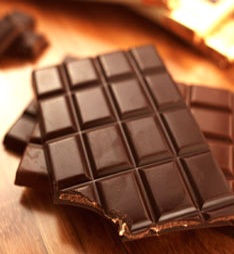

|
KAREN HOCHMAN is the Editorial Director of THE NIBBLE.
|
|
January 2006
Updated February 2009
|
 |
Tasting 101-Part 2: How to Taste Chocolate
Page 1: The Appearance & Snap of Gourmet Chocolate
Overview
Understanding how to taste chocolate requires lots of practice—which is music to the ears of any chocolate lover. Chocolate experts agree that the only way to learn how to taste is from plain bars. Anything else—bonbons, truffles or bars with nuts or other flourishes—gets in the way of analyzing the pure chocolate. But before you start tasting, you need to visit our prior article on Gathering The Bars To Taste. This is Page 1 of a two-page article. Click on the black links below to visit Page 2.
In an organoleptic* exploration of chocolate, one examines:
*Relating to perception by a sensory organ. The term is used extensively in food-tasting.
Appearance
First, look at the surface appearance of the bar.
- It should have an even texture and a shiny gloss with no discoloration, pitting or bloom. Good gloss is an indication of good tempering. Discoloration or bloom is an indication of chocolate that has been on the shelf too long and/or has undergone temperature changes, causing the fat or sugar to separate from the tempered chocolate. The feel should be neither too soft nor too brittle.
- Color is not an indication of quality, nor is it an absolute indicator of cacao content. While one might say in broad generalization that the higher the percentage of cacao, the darker the chocolate bar, that is only true within a particular producer and bean. For example, Porcelana, one of the finest beans in the world, is light in color—even at 85%. And if the producer prefers a dark roast, the chocolate will be darker in color.
- Cacao content—whether one prefers chocolate that is milk, semisweet, or bittersweet—is a matter of personal preference. A very dark bar containing a high percentage of cacao can be made with inferior cacao.
Snap
Professionals gauge the quality of chocolate by its “snap”: the clear, crisp sound made by breaking a piece of chocolate from a bar. A good, clean snap is indicative of high cacao content and well-tempered chocolate: the higher the cacao content, the harder the chocolate and the more pronounced the snap.
- The snap should be clean, without crumbling or bending. The opposite of snap is crumbly.
- Milk chocolate, which has lower levels of cocoa solids, and white chocolate which has no cocoa solids, are softer and don’t have the same clean snap as dark chocolate.
Continue To Page 2: Aroma
Go To The Article Index Above
Lifestyle Direct, Inc. All rights reserved. Images are the copyright of their individual owners.

|




